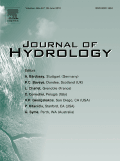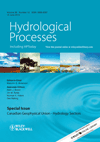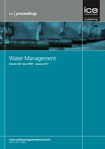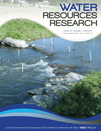
Journal of Hydrology
Scope & Guideline
Elevating Hydrological Insights to New Heights
Introduction
Aims and Scopes
- Hydrological Modeling and Forecasting:
Utilizes various modeling techniques, including machine learning and hybrid models, to predict hydrological processes such as streamflow, evaporation, and groundwater dynamics under changing climatic conditions. - Water Quality and Contamination Studies:
Investigates the impacts of human activities and natural processes on water quality, focusing on pollutants' sources, transport mechanisms, and their effects on aquatic ecosystems. - Climate Change and Hydrology:
Examines the effects of climate change on hydrological extremes, droughts, and water resource availability, providing insights for water management and policy adaptation. - Groundwater and Surface Water Interactions:
Studies the complex relationships between groundwater and surface water systems, including their responses to anthropogenic influences and natural variations. - Remote Sensing and Data Assimilation:
Employs advanced remote sensing technologies and data assimilation techniques to enhance the accuracy of hydrological models and improve water resource assessments. - Ecohydrology and Vegetation Dynamics:
Explores the interactions between hydrology and ecological systems, focusing on how vegetation influences water cycles and the implications for ecosystem services.
Trending and Emerging
- Machine Learning in Hydrology:
An increasing number of studies are utilizing machine learning techniques for hydrological modeling, data analysis, and prediction, reflecting a trend towards data-driven approaches. - Integrated Water Resources Management (IWRM):
There is a growing emphasis on IWRM, focusing on the interconnectedness of water, land, and energy resources, particularly in the context of sustainability and climate resilience. - Impact of Urbanization on Hydrology:
Research examining the effects of urbanization on hydrological processes, including runoff patterns and water quality, is gaining traction as cities face increasing flooding and water scarcity issues. - Hydrological Extremes and Climate Resilience:
Studies addressing the impacts of climate change on hydrological extremes, such as floods and droughts, are becoming more prevalent as societies seek to improve resilience. - Ecohydrological Approaches:
Research integrating ecological and hydrological perspectives to understand ecosystem responses to hydrological changes and to inform restoration practices is on the rise. - Use of Remote Sensing Technologies:
There is a notable increase in research employing remote sensing technologies for monitoring hydrological variables and assessing water resources, reflecting advancements in satellite capabilities.
Declining or Waning
- Traditional Hydrological Measurements:
Research utilizing conventional hydrological measurement techniques has decreased as newer technologies and remote sensing methods gain prominence. - Static Models for Water Resource Management:
There is a waning interest in purely static models, with a shift toward dynamic and adaptive modeling approaches that account for variability and change. - Historical Hydrology Studies:
The focus on purely historical analyses of hydrological data has diminished, with more emphasis being placed on predictive and scenario-based modeling. - Purely Theoretical Hydrological Frameworks:
Theoretical frameworks without empirical validation or practical application are less prevalent, as the journal emphasizes interdisciplinary and applied research.
Similar Journals

HYDROLOGICAL PROCESSES
Advancing Knowledge in Hydrological ResearchHYDROLOGICAL PROCESSES, published by WILEY, stands as a leading journal in the realm of Water Science and Technology. With an impressive impact factor and a prestigious ranking of Q1 in its category, the journal has carved a niche for itself since its inception in 1986, continuing to disseminate insightful research through to 2024. It boasts a solid Scopus ranking, sitting at #59 out of 261 in the Environmental Science field, placing it in the 77th percentile and emphasizing its relevance in the study of hydrological dynamics. Although not an open access journal, it provides essential and impactful articles that contribute to understanding hydrological phenomena, ensuring broad accessibility through libraries and institutional subscriptions. Researchers, professionals, and students alike will find HYDROLOGICAL PROCESSES a vital resource for the latest studies and advancements in water resource management and environmental sustainability.

PROCEEDINGS OF THE INSTITUTION OF CIVIL ENGINEERS-WATER MANAGEMENT
Exploring Innovations in Civil Engineering Water PracticesPROCEEDINGS OF THE INSTITUTION OF CIVIL ENGINEERS-WATER MANAGEMENT is a prestigious journal published by Emerald Group Publishing Ltd, dedicated to advancing the field of water management within civil engineering. With an ISSN of 1741-7589 and an E-ISSN of 1751-7729, this journal delivers peer-reviewed research that spans the critical intersections of water science and technology, contributing valuable insights into sustainable water management practices. As evidenced by its ranking in the 2023 Scopus categories, where it holds the Q3 quartile in Water Science and Technology, and a respectable position among its peers, the journal remains a vital resource for researchers, professionals, and students in the field. Though it is not an open-access journal, it offers accessible subscription options that facilitate worldwide dissemination of knowledge, enhancing its role as a fundamental reference point for cutting-edge developments in water management. For those looking to publish or stay updated on the latest research trends, this journal serves as an essential platform for promoting innovation and sustainable practices in civil engineering and water resources management.

Water Research X
Empowering researchers to tackle global water challenges.Water Research X is a prestigious journal published by ELSEVIER, focusing on the dynamic fields of water science and technology, pollution, ecological modeling, and waste management. Since its inception in 2018, this Open Access journal has become a cornerstone resource for researchers and professionals dedicated to advancing our understanding and management of water resources. Based in the United Kingdom, Water Research X holds an impressive ranking within the Scopus metrics, positioned in the Q1 category across multiple relevant disciplines, including Environmental Science, with a notable rank of 10/261 in Water Science and Technology and 3/41 in Ecological Modeling. This reflects its commitment to disseminating high-quality research that informs policy, supports sustainable practices, and fosters innovation in water management.

Water
Innovative insights into the world of water and its sciences.Water, an esteemed journal published by MDPI, serves as a pivotal resource for global research in the fields of aquatic science, biochemistry, geography, and water science and technology. Since its inception in 2009, this open-access journal has committed itself to advancing knowledge regarding water-related topics by fostering a platform that encourages the dissemination of high-quality research. With its impressive impact factor reflecting its relevance and influence, Water ranks in the top quartiles in various categories, including Q1 in Aquatic Science and Water Science and Technology, showcasing its commitment to publishing cutting-edge findings that resonate deeply with the environmental and biological sciences community. Located in Basel, Switzerland, the journal prioritizes accessibility for researchers, professionals, and students alike, aligning with the broader scientific goal of addressing urgent water challenges through collaborative and interdisciplinary research.

WATER RESOURCES RESEARCH
Connecting Science and Policy for Water SustainabilityWATER RESOURCES RESEARCH, published by the American Geophysical Union, stands as a premier journal in the field of environmental science, specifically within the domain of water science and technology. With an impressive impact factor and a categorical ranking of Q1 for 2023, it ranks within the top 10% of relevant journals, evidencing its critical role in advancing the knowledge and application of water resources research. Since its inception in 1965, the journal has been dedicated to rigorous research that addresses pressing global challenges related to water resource management, hydrology, and environmental sustainability. The journal's comprehensive publication scope aims to present innovative findings and methodologies that can shape effective policies and practices. Although it does not offer open access, the robust research it publishes continues to influence academics and practitioners alike, ensuring its position as an essential resource for anyone engaged in the pursuit of water-related knowledge and solutions.

Russian Meteorology and Hydrology
Unveiling the complexities of climate and water dynamics.Russian Meteorology and Hydrology is a distinguished journal published by PLEIADES PUBLISHING INC, specializing in the fields of meteorology and hydrology. With an ISSN of 1068-3739 and an E-ISSN of 1934-8096, this journal has been an authoritative source of research and insights since its inception in 1993. Aiming to disseminate cutting-edge research and foster discussions across related disciplines, it ranks in the Q4 category for Atmospheric Science and Q3 for both Fluid Flow and Transfer Processes as well as Water Science and Technology as of 2023. While currently not an open-access publication, it provides crucial insights essential for researchers, professionals, and students dedicated to understanding the complexities of climate systems and water resources. With its focus on innovative methodologies and comprehensive studies, Russian Meteorology and Hydrology remains a vital platform for advancing knowledge and practice in these critical domains.

Meteorology Hydrology and Water Management-Research and Operational Applications
Empowering researchers and policymakers through cutting-edge insights.Meteorology Hydrology and Water Management - Research and Operational Applications is a prominent academic journal published by the Institute of Meteorology and Water Management, based in Warsaw, Poland. With a focus on advancing the understanding and application of meteorology, hydrology, and water resource management, this journal plays a crucial role in disseminating high-quality research that contributes to both theoretical knowledge and practical applications in these pivotal fields. Although it operates under traditional access options, the journal is dedicated to providing valuable insights and solutions to challenges faced by researchers, practitioners, and policymakers in water management and environmental studies. Researchers keen on exploring innovative methodologies, operational tools, and empirical studies will find this journal an essential resource in enhancing their work and understanding of the dynamic interplay between meteorological phenomena and water resource management. The journal's commitment to maintaining rigorous scholarly standards ensures that every publication drives impactful dialogues within the community and beyond.

Hydrology Research
Innovative insights into hydrological processes.Hydrology Research, a leading academic journal published by IWA Publishing, is dedicated to advancing the field of water science and technology. With an impressive impact factor and a Q2 ranking in its category, the journal plays a pivotal role in disseminating innovative research and practices in hydrology. Established in 1973 and transitioning to an Open Access model in 2020, it provides unrestricted access to high-quality articles that cover a broad spectrum of topics, including hydrological processes, water management, and environmental impact assessments. Situated in Denmark, Hydrology Research continues to thrive as an essential platform for researchers, professionals, and students alike, encouraging the exchange of ideas that contribute to sustainable water solutions worldwide. With a comprehensive coverage of research converging from 1973 to 2024, it stands as a testament to ongoing progress in the water science community.

Journal of Applied Water Engineering and Research
Innovating Solutions for Sustainable Water ManagementJournal of Applied Water Engineering and Research is a dynamic platform dedicated to the advancement of knowledge in the field of water science and technology. Published by Taylor & Francis Ltd, this journal aims to bridge the gap between theoretical research and practical applications in water engineering, providing a crucial resource for researchers, practitioners, and policymakers. With an ISSN of 2324-9676 and an impressive ranking in the Q3 category for Water Science and Technology, it occupies a distinctive position within the scholarly community. The journal covers a wide spectrum of topics, including innovative water management strategies, sustainable practices, and the integration of technology in water resource management, thus contributing significantly to the discourse surrounding environmental sustainability. With publication years converging from 2013 to 2024, the Journal of Applied Water Engineering and Research continues to foster impactful research, enhancing our understanding and management of vital water resources.

Journal of Hydrology-Regional Studies
Shaping the future of water science through collaboration.Journal of Hydrology-Regional Studies, published by ELSEVIER in the Netherlands, stands as a leading open-access platform since 2014 for disseminating high-quality research in the fields of hydrology and water management. With an impressive impact factor and recognition as a Q1 journal in both Earth and Planetary Sciences and Water Science and Technology categories, it emphasizes regional studies that advance understanding of hydrological processes and their implications for sustainable management practices. The journal has established a significant global reach, evident from its Scopus rankings, which place it in the top percentiles within its disciplines, fostering a dynamic exchange of ideas among researchers, professionals, and students alike. By mobilizing critical insights and innovative solutions in hydrology, this journal aims to contribute to solving the pressing water-related challenges faced by our society.